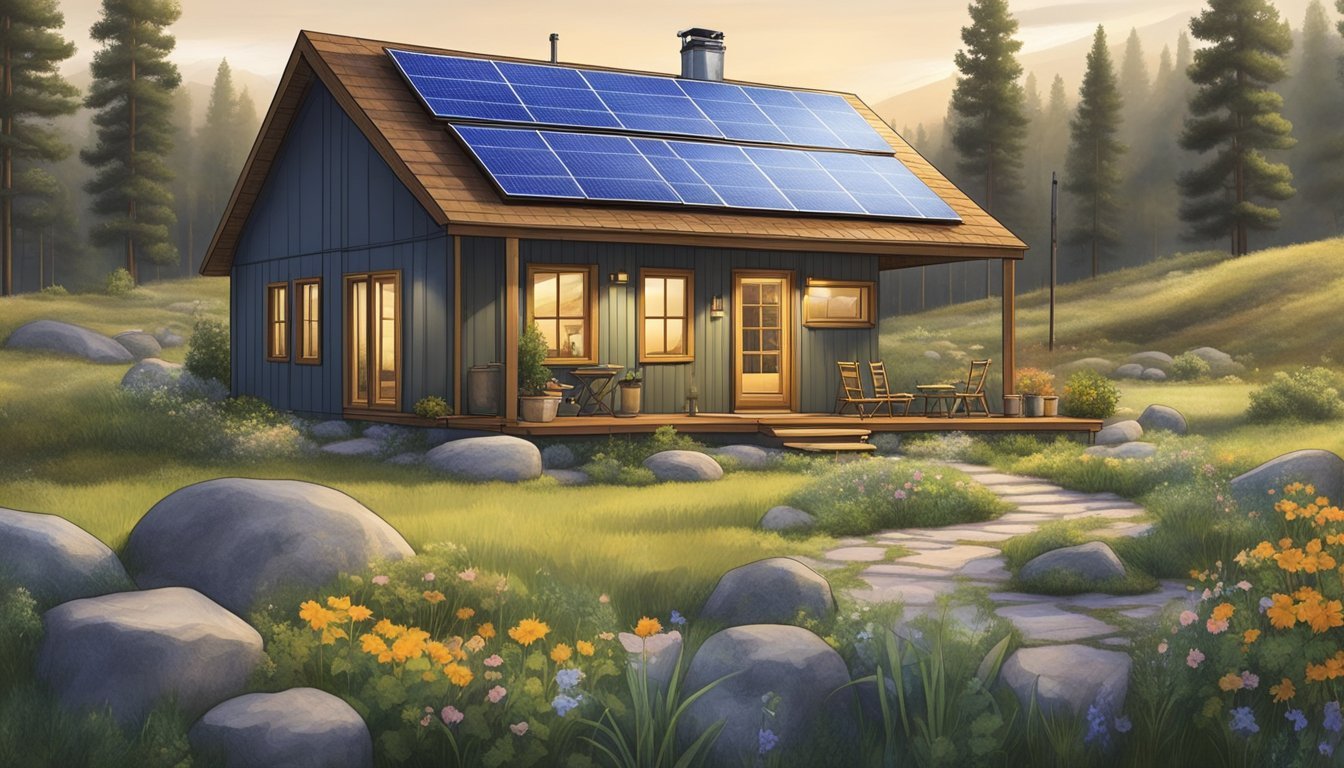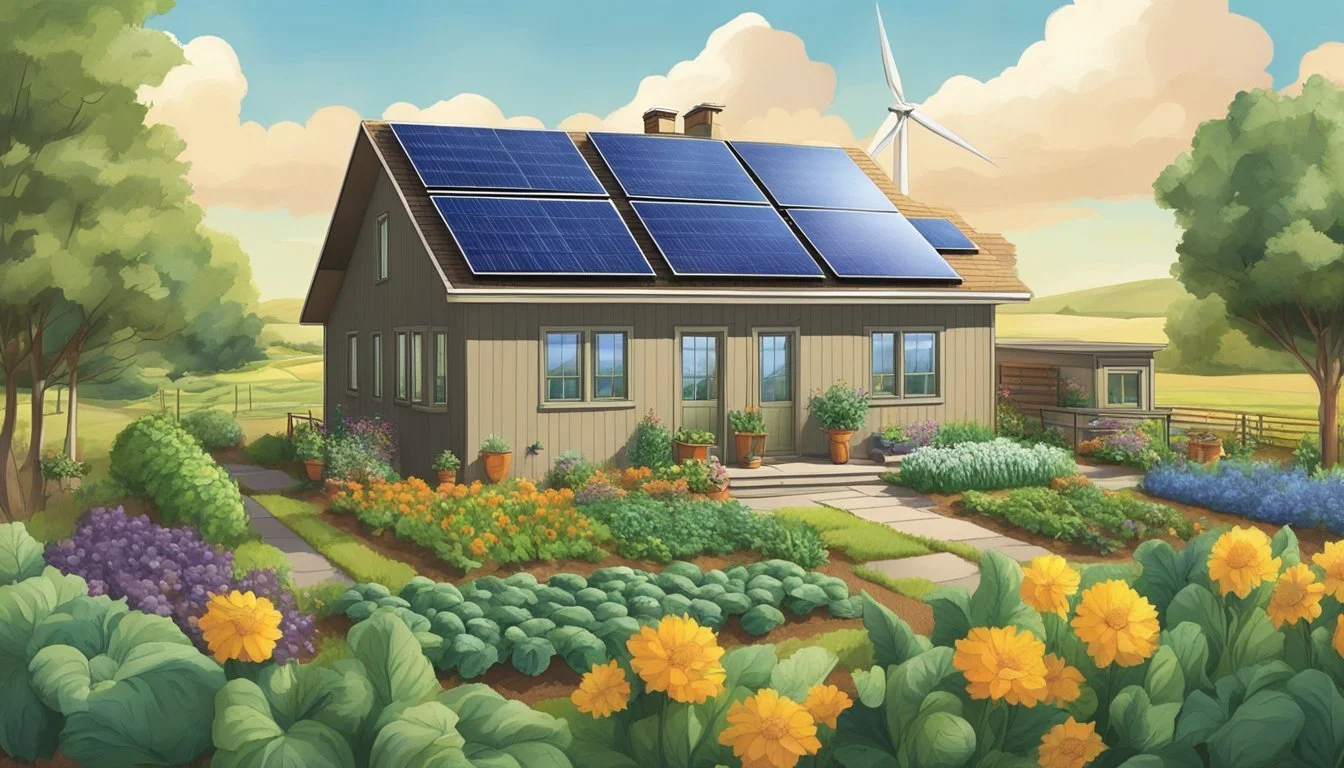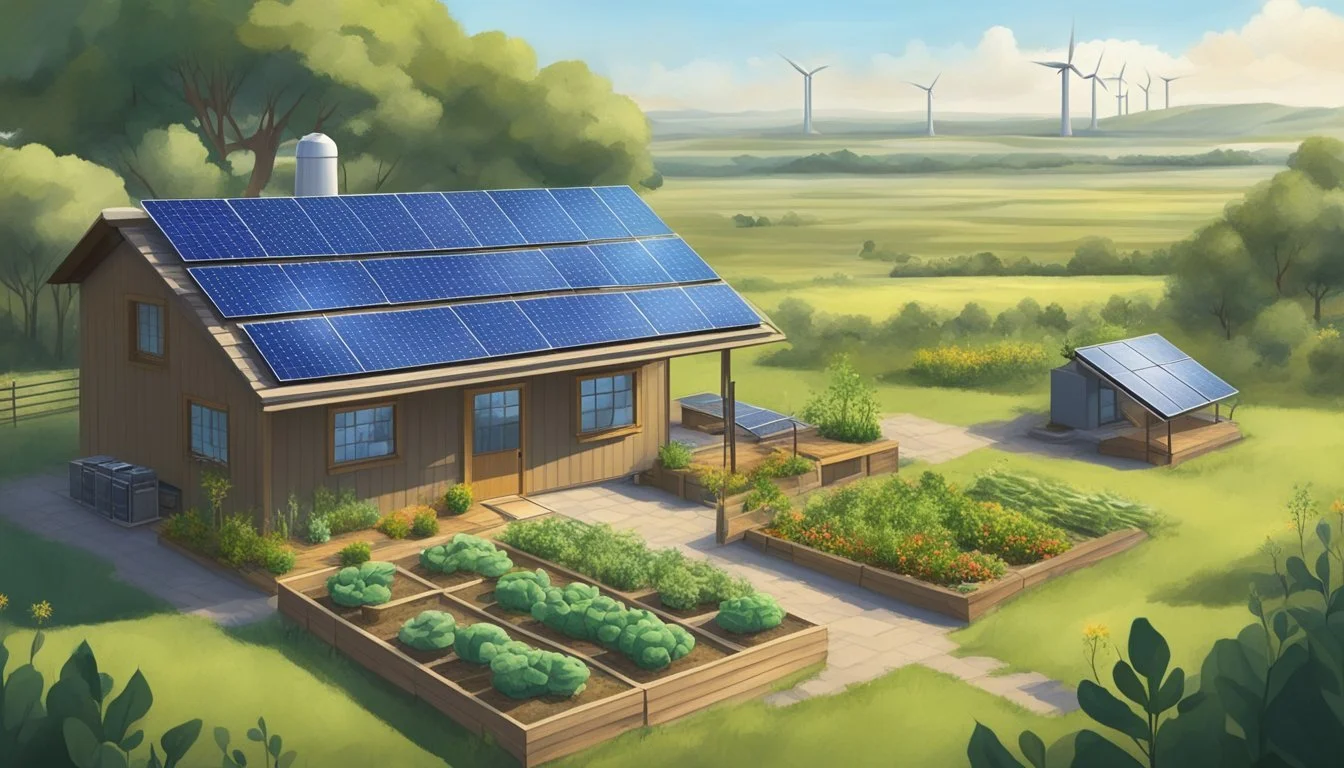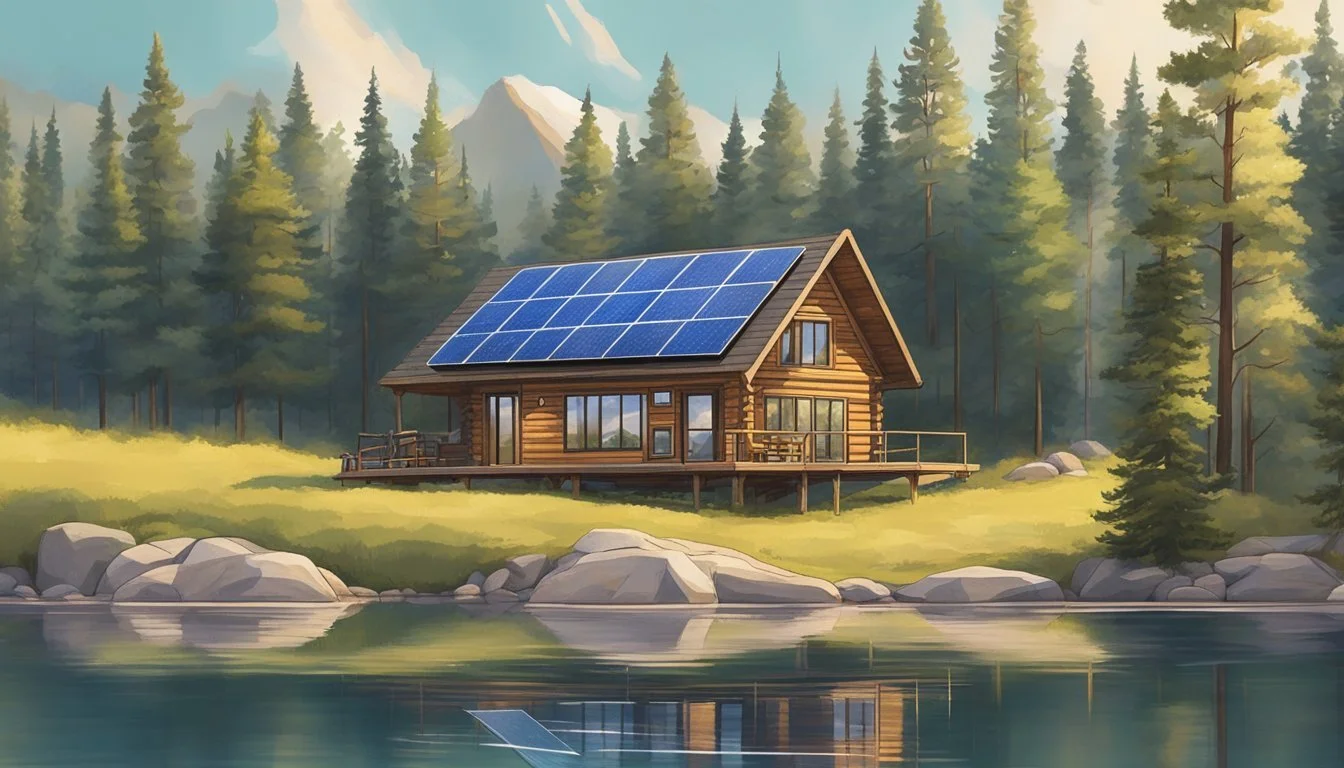How to Live Off Grid in South Dakota
Essential Tips and Resources
This Article is Part of Our Guide on Living Off-Grid for all 50 US-States
Living off the grid in South Dakota can be both challenging and rewarding for those who seek a more self-sufficient lifestyle amidst the state's rugged natural beauty. The vast prairies and affordable land make South Dakota an appealing option for individuals and families looking to disconnect from the modern world and embrace a more modest, independent way of life. Before diving into this adventure, it's crucial to understand the intricacies and legal aspects of living off the grid in South Dakota and how to overcome the potential challenges that may come with this decision.
The climate of South Dakota may be harsh during winters, yet it's full of promise and potential for off-grid enthusiasts. With plenty of sunshine, wind, and water resources, South Dakota offers a diverse range of choices for renewable energy systems such as solar and wind power. This ensures that those living off the grid can sustain their energy needs without relying on traditional power grids.
Adapting to an off-grid lifestyle in South Dakota may come with its fair share of hurdles, particularly concerning water rights, building regulations, and waste removal. Despite these challenges, many have found their own unique ways to navigate this landscape and create thriving and sustainable off-grid communities. Armed with knowledge and a sense of adventure, it's possible to embark on this fulfilling journey and build a life outside the confines of conventional society.
Understanding South Dakota's Off-Grid Potential
Natural Beauty and Environment
South Dakota is known for its stunning landscapes and natural beauty. The state boasts the iconic Mount Rushmore and the sprawling Black Hills, which are both popular tourist destinations. The state's population is estimated to be over 900,000 people, with the majority of residents living in rural areas. This makes South Dakota an ideal location for those who wish to live off-grid and enjoy a peaceful, rural lifestyle surrounded by nature.
Climate and Seasonal Challenges
While South Dakota offers abundant natural resources, it also presents some notable challenges with respect to climate and seasonal changes. The state is known for its harsh winters, which can be particularly difficult for those living off-grid.
Winters in South Dakota bring:
Low temperatures: The state experiences average lows of around 10°F (-12°C) in January, which can be challenging for off-grid living.
Heavy snowfall: Winters in South Dakota also come with significant snowfall, which can make traveling and accessing resources difficult for off-grid residents.
Short growing season: South Dakota has a relatively short growing season, which is something to consider when planning food production for off-grid living.
Despite these challenges, South Dakota still has great potential for off-grid living, thanks to its nature, available rural land, and enriching environment. By understanding the unique factors and challenges of the state, individuals can make informed decisions about pursuing an off-grid lifestyle in South Dakota.
Legal Considerations for Off-Grid Living
Zoning Laws and Building Codes
When planning to live off-grid in South Dakota, it's essential to understand the zoning laws and building codes that apply to your property. Zoning laws dictate how land can be used, while building codes regulate the construction and maintenance of structures. South Dakota generally permits off-grid living, but you may face some restrictions, especially regarding connection to municipal sewage and water systems. Additionally, certain off-grid systems such as compost toilets may be prohibited.
Make sure to check the local zoning laws and building codes to ensure compliance with regulations related to:
Land use and location of structures
Size and type of structures allowed
Electrical and plumbing systems
Waste disposal and sewage management
Land Ownership and Property Tax
Acquiring land for off-grid living in South Dakota comes with responsibilities like property taxes. Although you might live independently of the amenities provided by the government, you still need to pay property taxes on your land. To avoid any legal complications, ensure that you:
Obtain a clear and legal title to your land
Keep your property tax payment records up to date
Comply with any other state and local tax obligations
Water Rights and Regulations
South Dakota's water rights and regulations have a significant impact on off-grid living, often requiring permits or compliance with specific guidelines. Acquiring water rights and understanding off-grid water laws is an essential part of your off-grid journey in South Dakota. Some key points to keep in mind include:
Water Sources: Ensure that you have access to and the rights to use water sources on your property.
Water Rights Permits: Check if you need any permits for using water from wells, rivers, or other sources on your land.
Rainwater Harvesting Laws: In South Dakota, rainwater harvesting is allowed, but specific regulations might apply. Familiarize yourself with these laws to avoid potential legal issues.
Sewage and Waste Removal Laws: Compliance with sewage and waste removal regulations is crucial for off-grid living. Research the state and local laws to determine the best approach for waste disposal on your property.
By following these guidelines and ensuring adherence to relevant laws and regulations, you can confidently embark on your journey to off-grid living in South Dakota.
Selecting the Right Location
Rural Areas and Population Density
In South Dakota, the vast majority of residents live in rural areas, resulting in lower population density compared to other states. This provides ample opportunity for off-grid living, as there are wide expanses of land available for homesteading and sustainable living.
It is essential to choose a location with low population density to maintain privacy and minimize disturbances from neighbors. Some remote areas in South Dakota include Butte County, which offers a more isolated environment for off-grid living. However, it's crucial to balance the need for remoteness with access to resources and potential emergencies.
Proximity to Cities and Counties
While living off-grid often means a preference for seclusion, it's still important to consider proximity to cities and counties for access to essential services and resources. Here are some of the best counties in South Dakota for off-grid living:
Minnehaha County: Being close to Sioux Falls, the largest city in South Dakota, offers both rural and urban environments.
Pennington County: Home to the picturesque Black Hills, this county provides ample opportunities for nature enthusiasts while being nearby Rapid City.
Aurora County: Located in the southeastern part of the state, it offers both agricultural and natural resources for off-grid living.
Union County: Found in the southeastern corner of the state, this county neighbors major cities like Sioux City in Iowa, providing a mix of rural living and accessibility.
Clay County: Known for its lush landscapes, it is ideal for farming and sustainable living while being close to Vermillion.
Lincoln County: Situated near Sioux Falls, this county offers rural living combined with access to urban amenities.
Yankton County: This location boasts proximity to both Yankton and the Missouri River, offering diverse opportunities for off-grid living.
Bon Homme County: Located along the Missouri River, this region provides an excellent environment for homesteading and natural resources.
While considering the right location for your off-grid lifestyle in South Dakota, prioritize areas that offer a balance between low population density and access to essential services and resources. These counties provide an excellent starting point for your search, along with exploring more remote locations if desired.
Developing Sustainable Infrastructure
Living off-grid in South Dakota requires developing a sustainable infrastructure that addresses power, water, sanitation, and food production. Implementing efficient systems ensures a comfortable and environmentally friendly off-grid lifestyle by utilizing local resources and renewable energy sources.
Power Solutions
Harnessing renewable energy is crucial for off-grid living in South Dakota. The two primary sources of renewable energy in the region are solar and wind power.
Solar power is accessible and efficient, with South Dakota receiving ample sunlight throughout the year. Installing solar panels on your off-grid property can provide you with a sufficient energy supply. However, it is essential to assess your solar system's size by considering your energy consumption and available budget.
Wind power is another viable option, as South Dakota has abundant wind resources. Installing a wind turbine can complement your solar setup, providing energy when solar power is less available, such as during cloudy days or winter months.
Water Systems and Sanitation
Sustainable water systems are essential for off-grid living in South Dakota. A common approach to obtaining water for daily use is through rainwater harvesting. Building a rainwater collection system using gutters, storage tanks, and filters can provide clean water for drinking, cooking, and cleaning.
In addition to sourcing water, it is crucial to have proper sanitation systems in place. Composting toilets and environmentally friendly greywater systems can be used to manage waste, reducing the impact on the environment, and conserving water.
Self-Sufficient Food Production
To achieve self-sufficiency, off-grid residents in South Dakota need to engage in sustainable farming practices. Since the state experiences short growing seasons, it is vital to select crops that can thrive in the local climate. Some options include:
Cold-hardy vegetables: cabbage, kale, carrots, and beets
Fast-maturing crops: lettuce, radishes, and peas
Perennial plants: asparagus, rhubarb, and berries
Raising livestock is another potential way to supplement your food supply, with chickens providing eggs and goats offering milk and cheese. Additionally, practicing crop rotation, composting, and organic pest control will help maintain soil health and promote self-sufficient food production. Furthermore, preserving food through canning, drying, and fermenting can allow you to rely on your harvest throughout the year.
Implementing sustainable infrastructure in your off-grid South Dakota residence ensures energy efficiency, responsible water and waste management, and self-sufficient food production. By embracing these practices and harnessing local resources, you can enjoy a fulfilling and environmentally conscious lifestyle in the state.
Building an Off-Grid Home
Designing for Efficiency
When building an off-grid home in South Dakota, it is crucial to focus on designing a space that is efficient in terms of energy consumption and resource usage. One way to achieve this is by incorporating passive solar design principles, which leverage natural sunlight for heating and cooling purposes.
Insulation plays a significant role in energy efficiency. Opt for high-quality insulation materials to reduce heat loss during cold South Dakota winters and retain cool air in summer. Make proper use of insulation in the walls, roof, and floors.
Moreover, choose energy-efficient windows and doors to further improve your home's insulation. Look for windows with low-emissivity coatings and double or triple panes filled with gas for better insulation.
Alternatives to Traditional Utilities
When living off-grid, finding alternatives to traditional utilities is a must. Here are some options for off-grid electricity, water, and waste management:
Off-grid electricity:
Solar power: Solar panels are a popular choice in South Dakota, allowing homeowners to harness the sun's energy for electricity. Be sure to install a battery system for energy storage during cloudy days or nighttime.
Wind power: South Dakota has excellent wind resources, making wind turbines another viable option for generating electricity.
Water and waste management:
Wells: Drilling a well for freshwater could be a suitable option for off-grid homes in South Dakota. However, it is essential to be aware of any water rights or permits required for tapping into groundwater resources.
Rainwater harvesting: Collect rainwater and store it in a suitable container for later use. Rainwater can be used for irrigation, washing, and, after proper treatment, for drinking water.
Compost toilets: Instead of traditional sewage systems, consider using compost toilets, which convert human waste into nutrient-rich compost for gardens. Be aware that some regulations apply to compost toilets in South Dakota, so ensure compliance before installation.
EPA certified wood stoves: For heating purposes, opt for EPA certified wood stoves which are highly efficient and environmentally friendly compared to traditional fireplaces.
By considering these efficient designs and alternatives to traditional utilities, it is possible to build a self-sufficient, off-grid home in South Dakota that embraces the principles of sustainable living.
Financial Aspects
Initial Costs and Investments
When considering living off-grid in South Dakota, the first factor to evaluate is the initial cost of investment. One of the primary expenses is purchasing land for your off-grid homestead. South Dakota is known for its affordable land prices, especially in comparison to other states. The cost of land can vary depending on factors such as location, accessibility, and proximity to utilities.
Location Average Land Price per Acre Eastern SD $2,000 - $4,000 Central SD $1,000 - $2,500 Western SD $500 - $1,500
Please note that these prices are estimates and can change over time.
In addition to land, there will be expenses for building your off-grid home, such as materials and labor costs. These can range from a few thousand to tens of thousands of dollars depending on the complexity of your project and whether you choose to hire a contractor or do it yourself. Renewable energy systems, like solar panels or wind turbines, are another essential investment for off-grid living.
Ongoing Expenses and Living Cost
While living off-grid can save you money on certain utilities, there are still ongoing expenses to consider. Property taxes in South Dakota may be relatively high compared to other states. The property tax rate can vary between 1% and 3% based on the location and the assessed value of your property.
Water rights and management can also have costs associated with them, even if you're using water on your property. For example, you might need to pay fees for drilling wells or establishing a rainwater collection system. Maintenance and replacement costs for your renewable energy systems should also be taken into account.
It's essential to have a clear understanding of the cost of living when planning your off-grid lifestyle in South Dakota. While you may save money on some expenses, others may increase, such as grocery costs due to the rural location, or fuel costs for heating during the harsh winter months.
Community and Lifestyle
Joining Off-Grid Communities
When considering living off-grid in South Dakota, it is important to find a community of like-minded individuals who share your values and lifestyle preferences. Off-grid communities often consist of members who are committed to sustainable living, a self-reliant lifestyle, and a deep connection with nature. Joining one of these communities can provide a strong support network, as well as valuable knowledge, skills, and resources.
There are various ways to find off-grid communities in South Dakota:
Online search: Research existing off-grid communities, forums, and social media groups focused on South Dakota. This can help you connect with people already living off-grid in the state, or those planning to do so.
Local resources: Attending workshops, events, and local gatherings centered around sustainability and off-grid living can lead to finding communities to join.
Networking: Speak to people who have firsthand experience with off-grid living in South Dakota. Their insights can help guide you in choosing the right community for your needs.
Adapting to Off-Grid Culture
Once you have found a community in South Dakota, it is essential to adapt to the culture and lifestyle of off-grid living:
Developing new skills: Living off the grid requires specific skills such as gardening, animal husbandry, and renewable energy systems management. Learning these skill sets will help you become self-reliant and contribute to the community.
Embrace sustainable living: Off-grid communities often place a strong emphasis on sustainability. Adopt eco-friendly practices like recycling, composting, and conserving water to reduce your environmental footprint.
Foster connections with nature: One of the key aspects of off-grid living in South Dakota is a deep connection with nature. Engage in outdoor activities like hunting, fishing, hiking, and foraging to help you appreciate and understand the natural environment.
Build strong relationships: Forming bonds with fellow community members not only helps establish a support network, but it also contributes to individual and group growth. Participate in community events and projects to foster these connections.
Manage isolation: Some off-grid communities in South Dakota may be situated in remote locations, leading to potential isolation. Actively participating in social activities within your community and staying connected with friends and family outside the community can help mitigate feelings of isolation.
Self-Reliance Skills
Environmental Conservation
Living off the grid in South Dakota demands a strong focus on self-sufficiency and sustainability. It is essential to consider the resources available and harness them efficiently. Typically, self-reliant individuals look to renewable energy sources, such as solar panels and wind turbines. However, the winter months in South Dakota can pose challenges in generating power. As such, it is crucial to be resourceful in managing energy consumption.
Another aspect of environmental conservation is maintaining a balance with the local wildlife. This includes practicing ethical hunting and fishing techniques, ensuring that the ecosystem remains intact. South Dakota's diverse fauna, such as deer and fish, can be a valuable source of food for off-grid living, provided conservation principles are respected.
Lastly, growing and harvesting crops is essential in South Dakota, although the short growing seasons require careful planning. Selecting suitable crops that can flourish in the local climate is key to a sustained and bountiful harvest.
Emergency Preparedness
South Dakota can face a variety of natural disasters and other emergencies, making preparedness indispensable for off-grid living. Understanding the potential threats and preparing accordingly can ensure self-reliance even in difficult situations. Some key areas of focus include:
Power: Having backup power supplies, such as generators, batteries, or alternative energy sources, is crucial to maintain essential household functions during interruptions.
Food Storage: Preserving food and maintaining an adequate supply of non-perishable goods helps ensure sustenance during emergencies.
Water: Proper water storage and purification methods are vital, given the importance of water rights and legal access to water sources in South Dakota.
Shelter: Maintaining a well-insulated shelter, especially during the harsh winters, can help reduce energy consumption and protect against extreme weather conditions.
Security: Although the crime rate is generally low in rural South Dakota, it is still essential to take necessary precautions and remain aware of any potential risks or dangers.
In summary, living off the grid in South Dakota demands an array of self-reliance skills, from environmental conservation to emergency preparedness. Balancing self-sufficiency with sustainability, while respecting wildlife and the local environment, will enable off-grid dwellers to successfully adapt and thrive in their chosen lifestyle.
Environmental Impact and Ethics
Wildlife Interaction and Land Stewardship
Living off-grid in South Dakota offers a unique opportunity to interact with the local wildlife and take on the responsibility of land stewardship. By living in harmony with nature and using sustainable practices, off-grid residents can help preserve the state's diverse ecosystems and species. This includes:
Responsible agriculture: Implementing sustainable agriculture techniques, such as crop rotation, organic farming, and permaculture, can minimize the impact on the environment and protect the wildlife.
Habitat conservation: Preserving and creating habitats for native species by, for example, planting native shrubs and trees or providing nesting boxes for birds.
Avoiding disruption: Reducing the impact on wildlife by keeping noise and light pollution to a minimum and respecting the natural patterns of animal life.
Eco-Conscious Building Practices
To lessen the environmental impact of off-grid living in South Dakota, residents should consider using eco-conscious building practices when constructing their homes. Doing so can help conserve energy, reduce waste, and minimize the use of non-renewable resources. Some practices to consider include:
Material selection: Using reclaimed, recycled, or sustainably-sourced materials for construction, such as reclaimed wood, metal roofing, and straw bales.
Alternative construction methods: Exploring environmentally friendly construction techniques, like earthships, cob houses, or rammed earth walls.
Energy-efficient design: Incorporating passive solar design principles, proper insulation, and efficient ventilation to reduce heating and cooling needs.
Water conservation: Employing water-saving features like rainwater harvesting systems, greywater recycling, and low-flow fixtures.
By following these guidelines and considering the environmental impact of their lifestyle choices, off-grid residents in South Dakota can contribute to the preservation of the state's unique wildlife and ecosystems while also enjoying a self-sufficient, sustainable way of life.
Recreation and Leisure
Outdoor Activities and Sports
South Dakota is a haven for outdoor enthusiasts, avid sportsmen, and nature lovers in general. The state offers a wide range of activities to enjoy while living off the grid such as hiking, fishing, hunting, and more.
Fishing opportunities abound in the numerous lakes, rivers, and streams. Fish species found in South Dakota waters include walleye, trout, perch, and northern pike. Spearfishing is a popular pastime in the state as well, especially in places like Spearfish, where opportunities for anglers are aplenty.
For those who enjoy hunting, South Dakota is home to a variety of wildlife, such as deer and coyotes. The state has designated hunting seasons and regulations to ensure sustainable populations of these species and to provide a safe and enjoyable experience for hunters.
Here are some popular off-grid friendly places for outdoor recreation in South Dakota:
Black Hills National Forest - Offers a diverse range of activities such as hiking, camping, and rock climbing.
Badlands National Park - A unique landscape ideal for photography, hiking, and stargazing.
Custer State Park - Home to numerous trails for hiking, biking, and horseback riding.
Cultural and Historical Sites
South Dakota also offers various opportunities to immerse oneself in its rich cultural and historical heritage. Visiting the state's iconic landmarks and historical sites is a must for those living off-grid.
One of the most famous landmarks is Mount Rushmore, a national memorial featuring the carved faces of four US presidents. This site draws visitors from all around the world, making it a popular destination for locals and off-grid residents alike.
In addition to Mount Rushmore, South Dakota is home to several other sites of cultural and historical significance, such as:
Crazy Horse Memorial: An ambitious tribute to the famous Lakota leader, this monument is still under construction and is dedicated to preserving Native American culture.
Deadwood: A historic town that played a significant role in the United States' westward expansion, offering a glimpse into the past with restored buildings, reenactments, and guided tours.
Wind Cave National Park: One of the oldest national parks in the US, featuring an extensive network of underground passageways and unique cave formations.
Living off the grid in South Dakota doesn't mean sacrificing recreation and leisure opportunities. With an abundance of outdoor activities, sports, and cultural and historical sites, there's always something to do and see in this beautiful state.





